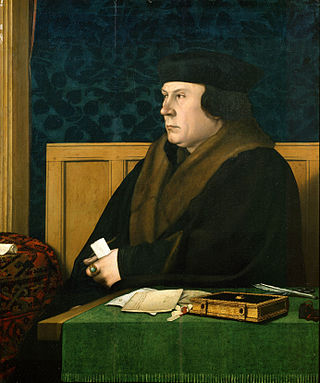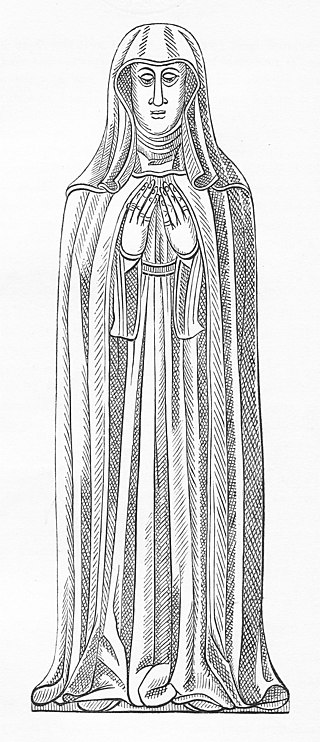Related Research Articles

Thomas Wolsey was an English statesman and Catholic cardinal. When Henry VIII became King of England in 1509, Wolsey became the king's almoner. Wolsey's affairs prospered and by 1514 he had become the controlling figure in virtually all matters of state. He also held important ecclesiastical appointments. These included the Archbishop of York—the second most important role in the English church—and that of papal legate. His appointment as a cardinal by Pope Leo X in 1515 gave him precedence over all other English clergy.

Anne Boleyn was Queen of England from 1533 to 1536, as the second wife of King Henry VIII. The circumstances of her marriage and execution, by beheading for treason, made her a key figure in the political and religious upheaval that marked the start of the English Reformation.

Anne of the Thousand Days is a 1969 British historical drama film based on the life of Anne Boleyn, directed by Charles Jarrott and produced by Hal B. Wallis. The screenplay by Bridget Boland and John Hale is an adaptation of the 1948 play of the same name by Maxwell Anderson.

Thomas Cromwell, briefly Earl of Essex, was an English statesman and lawyer who served as chief minister to King Henry VIII from 1534 to 1540, when he was beheaded on orders of the king, who later blamed false charges for the execution.

Mary Tudor was an English princess who was briefly Queen of France as the third wife of King Louis XII. Louis was more than 30 years her senior. Mary was the fifth child of Henry VII of England and Elizabeth of York, and the youngest to survive infancy.

George Boleyn, Viscount Rochford was an English courtier and nobleman who played a prominent role in the politics of the early 1530s as the brother of Anne Boleyn, second wife of King Henry VIII. George was the maternal uncle of Queen Elizabeth I, although he died long before his niece ascended the throne. Following his father's promotion in the peerage in 1529 to Earl of Wiltshire and Earl of Ormond, he adopted his father's junior title Viscount Rochford as a courtesy title. He was accused of incest with his sister Anne during the period of her trial for high treason, as a result of which both were executed.

Wilton Abbey was a Benedictine convent in Wiltshire, England, three miles west of Salisbury, probably on the site now occupied by Wilton House. It was active from the early tenth century until 1539.

Elizabeth Barton, known as "The Nun of Kent", "The Holy Maid of London", "The Holy Maid of Kent" and later "The Mad Maid of Kent", was an English Catholic nun. She was executed as a result of her prophecies against the marriage of King Henry VIII of England to Anne Boleyn.

William Carey was a courtier and favourite of King Henry VIII of England. He served the king as a Gentleman of the Privy chamber, and Esquire of the Body to the King. His wife, Mary Boleyn, is known to history as a mistress of King Henry VIII and the sister of Henry's second wife, Anne Boleyn.
MargaretSpencer (1472–1536) was the daughter of Sir Robert Spencer, of Spencer Combe in the parish of Crediton, Devon, by his wife Lady Eleanor Beaufort, the daughter of Edmund Beaufort, 2nd Duke of Somerset and Lady Eleanor Beauchamp.
Events from the 1530s in England.

Mary Boleyn, also known as Lady Mary, was the sister of English queen consort Anne Boleyn, whose family enjoyed considerable influence during the reign of King Henry VIII.
Bridget Wiltshire was an English courtier. She was the neighbour, close friend and lady-in-waiting to Anne Boleyn, the second wife of Henry VIII of England. She was the wife of Sir Richard Wingfield and the daughter of Sir John Wiltshire of Stone Castle, Kent, a neighbour of the Boleyn family.
Dame Eleanor Carey was an early modern English noblewoman and nun, known for being endorsed as a candidate for abbess of Wilton Abbey by Anne Boleyn until her scandalous life was discovered.

Sir John Cary (or Carey) (c. 1491 – 1552), of Pleshey in Essex, was a courtier to King Henry VIII, whom he served as a Groom of the Privy Chamber, and of whom he was a third cousin, both being 4th in descent from John Beaufort, 1st Earl of Somerset (1371-1410).
Lady Elizabeth FitzGerald, Countess of Kildare, was an Anglo-Irish noblewoman, the second wife of Gerald FitzGerald, 9th Earl of Kildare. Her father was Thomas Grey, 1st Marquess of Dorset. Her mother, Cecily, was the wealthiest heiress in England after succeeding to the title of suo jure 7th Baroness Harington of Aldingham and then the title of suo jure 2nd Baroness Bonville.

Anne Gainsford, Lady Zouche was a close friend and lady-in-waiting to Queen consort Anne Boleyn.

Cecily Bodenham was the last abbess of Wilton Abbey. Her tenure as abbess was from 1534 to 25 March 1539, when she surrendered the abbey to the commissioners of King Henry VIII of England during the Dissolution of the Monasteries. She received a generous pension and a property at Fovant, where she retired with about ten of the nuns from Wilton.

The Abbey of the Minoresses of St. Clare without Aldgate was a monastery of Franciscan women living an enclosed life, established in the late 13th century on a site often said to be of five acres, though it may have been as little as half that, at the spot in the parish of St. Botolph, outside the medieval walls of the City of London at Aldgate that later, by a corruption of the term minoresses, became known as The Minories, a placename found also in other English towns including Birmingham, Colchester, Newcastle upon Tyne and Stratford-upon-Avon.

Agnes Jordan was the last pre-reformation Abbess of Syon Monastery. It was she who had to sign the deed of surrender on 25 November 1539 which brought to an abrupt end the life of the abbey and granted all its property and wealth to Henry VIII. She was the sister of Isabel Jordan, prioress and later abbess of Wilton Abbey.
References
- 1 2 3 4 "Jordayne, Isabel (d. in or before 1534), abbess of Wilton" . Oxford Dictionary of National Biography (online ed.). Oxford University Press. 2004. doi:10.1093/ref:odnb/104420. ISBN 978-0-19-861412-8 . Retrieved 2021-02-18.(Subscription or UK public library membership required.)
- 1 2 British History Online (.ac.uk) Abbey of Wilton
- ↑ Loades, David (2011-02-15). Henry VIII. Amberley Publishing Limited. p. 1567. ISBN 978-1-4456-0665-1.
- 1 2 "Houses of Benedictine nuns: Abbey of Wilton | British History Online". www.british-history.ac.uk. Retrieved 2021-02-18.